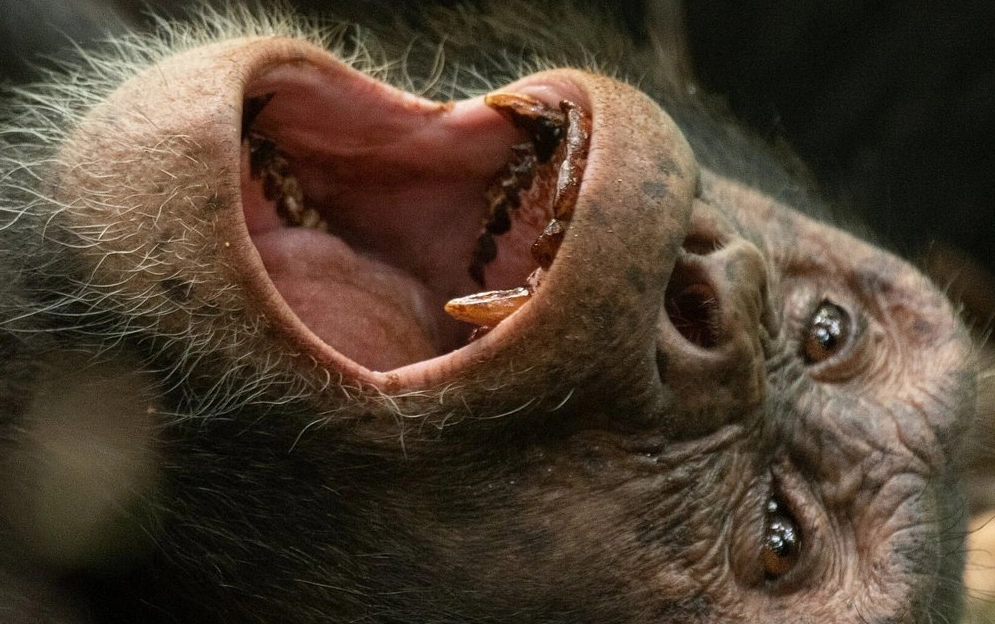A chimpanzee call can travel for more than a kilometer through dense rainforest. It is not background noise. It is strategy, survival, and social politics echoing through the trees.
Key Takeaways
- Chimpanzee sounds include pant-hoots, screams, grunts, and drumming on tree buttresses.
- Each sound carries specific meaning tied to dominance, fear, food, or bonding.
- Their communication reveals a culture with rules, hierarchies, and surprising nuance.
- Hearing these calls on safari is as profound as seeing the chimps themselves.
Why Chimpanzees Vocalize in the Forest
Chimpanzees live in complex societies where alliances and rivalries shape daily life. Silence is not an option. Calls ripple through the canopy to signal safety, warn of danger, or summon allies.
Unlike the tidy categories of human language, chimp sounds overlap. Anger shades into fear, play blurs into protest.
What matters is context. A pant-hoot from an alpha male is not the same as a pant-hoot from a juvenile. The forest is a stage where each voice reveals both individual and group dynamics.
For travelers walking into a Ugandan forest, these sounds are not just wildlife background. They are an invitation to listen in on a society negotiating itself in real time.
The Major Chimpanzee Sounds You Might Hear
1. Pant-hoots
Perhaps the most iconic call, pant-hoots rise from soft grunts into high-pitched screams, often accompanied by chest beating or branch shaking. These are declarations of presence, strength, and alliance. When several males pant-hoot together, it is both bonding ritual and intimidation strategy.
2. Screams
Sharp, urgent, impossible to ignore. Screams often erupt during conflict or when lower-ranking chimps protest aggression from higher-ranking ones. They are also heard when predators or sudden threats appear.
3. Grunts and barks
Shorter sounds, often used during feeding. A low grunt can signal reassurance, while sharper barks warn others away from contested food. Researchers sometimes compare these to the “everyday speech” of chimps, functional and constant.
4. Drumming
Chimpanzees beat on hollow tree buttresses with their hands and feet. The sound carries farther than a vocal call, echoing like distant drums. These rhythmic displays mark territory and can reinforce dominance without direct confrontation.
Sound, Like Sight, is Very Powerful
Most safari conversations focus on what you see, such as silverback gorillas in Bwindi, elephants on the savannah, or lions at dusk.
But sound is just as powerful. Listening to chimpanzees in Kibale Forest or Budongo is not a sideshow. It is immersion into a layered culture.
This perspective also challenges the way safaris are often marketed. Too often, the experience is framed as silent observation of exotic creatures.
Yet a forest alive with chimpanzee sounds forces us to recognize them as active agents in their own story, shaping and broadcasting their social world.
If you are considering a Gorilla and Chimpanzee Trekking safari in Uganda, know that the sounds you hear along the way may stay with you as vividly as the encounters themselves.
Ethical Dimension of Listening
There is a temptation to treat chimpanzee calls like entertainment. But for the chimps, these sounds are urgent, sometimes playful, sometimes desperate, sometimes lethal in consequence.
Guides who frame them respectfully remind travelers that we are eavesdropping on lives as complex as our own.
This is also where responsible travel in Uganda comes in. Keeping a respectful distance reduces stress on the chimps and ensures their vocal world remains theirs, not ours to manipulate.
Listening to chimpanzees in the forest is more than wildlife watching. It is overhearing the pulse of another society.
If you are ready to experience this firsthand, request a quote and we will help you plan a journey where sound is part of the story.
FAQs About Chimpanzee Sounds
What does a chimpanzee pant-hoot mean?
It can signal excitement, dominance, or group solidarity. The meaning depends on context and who is calling.
Do chimpanzees really drum on trees?
Yes. They use large buttress roots as natural amplifiers, creating sounds that carry across the forest.
Where can I hear chimpanzee sounds in Uganda?
Top locations include Kibale Forest National Park, Budongo Forest near Murchison Falls, and Kyambura Gorge in Queen Elizabeth National Park.
Are chimp sounds unique to each community?
Research suggests chimpanzee groups develop local “dialects” in their pant-hoots, shaped by culture as much as biology.





